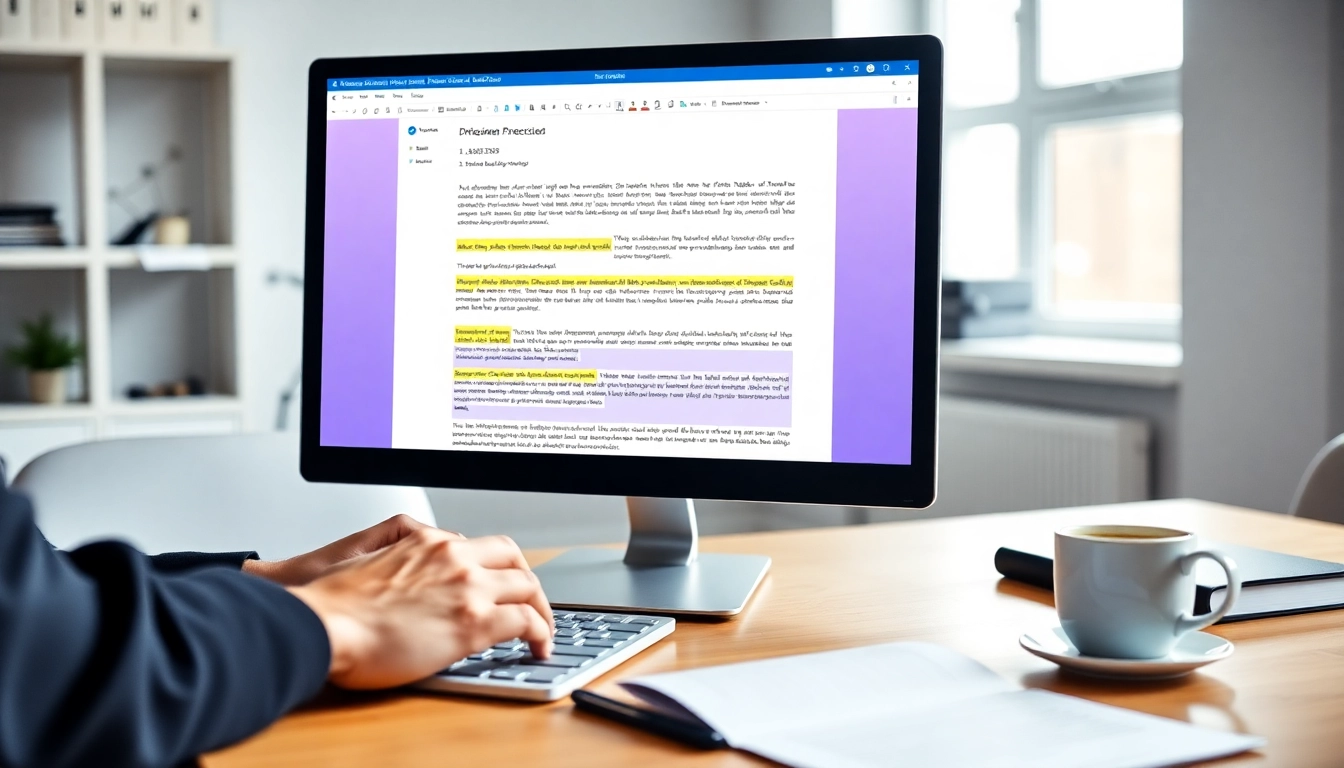Enhance Your Writing with a Reliable Plagiarism Checker Tool
Understanding Plagiarism and Its Consequences
What is Plagiarism?
Plagiarism involves using someone else’s work, ideas, or expressions without proper acknowledgment, presenting them as one’s own. It can manifest in various forms, including direct copying, paraphrasing without citation, and even self-plagiarism, where an author reuses their previously published work without permission. The accessibility of digital content has exacerbated this issue, making it easier for students and professionals alike to unwittingly commit plagiarism. This underscores the importance of utilizing a reliable plagiarism checker to safeguard originality and enhance one’s writing credibility.
The Ethical Implications of Plagiarism
Ethically, plagiarism breaches the trust fundamental to academic and professional communities. It undermines the integrity of knowledge by falsely attributing merit to individuals who do not deserve it. This not only affects the plagiarizer but also devalues the efforts of genuine authors, potentially harming their reputations and careers. From academic settings to business environments, the ramifications of plagiarism can lead to a loss of credibility, legal action, and disciplinary measures, including expulsion or termination. Understanding these ethical implications compels individuals to prioritize originality in their work, fostering a culture of respect for intellectual property.
Consequences for Students and Professionals
The consequences of plagiarism can be severe for both students and professionals. For students, engaging in plagiarism can lead to academic penalties, including failing grades, suspension, or even expulsion from educational institutions. These actions not only affect immediate academic outcomes but also long-term educational and career prospects. Similarly, for professionals, allegations of plagiarism can result in job loss, damaged reputations, and legal consequences. Developing a habit of original writing and diligent citations is crucial to mitigate these risks and ensure compliance with academic and professional standards.
How a Plagiarism Checker Works
Features of a Comprehensive Plagiarism Checker
A robust plagiarism checker features several essential capabilities that enhance its utility. The primary function is to scan documents and compare them against a vast database of academic papers, online articles, and various other sources to detect similarities in text. Key features include:
- Multilingual Support: Many advanced checkers support multiple languages, making them useful for non-English texts.
- Source Identification: A good plagiarism checker provides detailed reports that indicate the specific sources from which the content is derived.
- Originality Reports: These tools generate reports that outline the percentage of text matching known sources, helping users understand the extent of similarity.
- User-Friendly Interface: Ease of use is crucial; an intuitive interface enables users to quickly check their documents without extensive technical knowledge.
Algorithm and Comparison Methods
Plagiarism checkers employ sophisticated algorithms to analyze and compare texts. Common approaches include:
- String Matching: This method detects exact matches of phrases or sentences within the submitted document and the database.
- Semantic Analysis: Advanced tools utilize natural language processing (NLP) to identify similar ideas expressed differently, which helps catch paraphrased content.
- Citation Pattern Recognition: Some algorithms are designed to evaluate the context of citations and identify any improper or missing attributions.
By combining these techniques, plagiarism checkers provide a comprehensive understanding of the originality of the text.
Accuracy and Reporting Standards
The accuracy of a plagiarism checker significantly influences its reliability. The best plagiarism checkers update their databases regularly to include the latest publications and academic works. Furthermore, they offer varying reporting standards to ensure users can easily understand their results. Typical criteria for accurate reporting include:
- Threshold Settings: Users can often set their acceptable similarity thresholds, allowing for flexibility based on the type of work being assessed.
- Detailed Report Breakdown: Comprehensive reports highlight matched segments, source links, and context, which aids in identifying areas needing revision.
- Initial vs. Final Report Comparison: Some advanced tools provide initial and final reports to show changes after adjustments, further assessing the effectiveness of mitigating plagiarism.
Benefits of Using a Plagiarism Checker
Ensuring Originality in Your Work
Utilizing a plagiarism checker primarily fosters the originality of work by verifying content against existing sources. With the capability to identify unintentional plagiarism, these tools empower authors to make necessary changes before submission or publication. This proactive approach not only upholds ethical standards but also enhances personal credibility and professionalism in writing.
Improving Writing Skills and Grammar
Beyond plagiarism detection, many checkers offer insights into grammar and writing style. Features often include:
- Grammar Checking: Identifying grammatical errors enhances the overall quality of writing, ensuring clear and effective communication.
- Style Recommendations: Some tools provide suggestions for improving writing style, tone, and readability, which help evolve a writer’s skill set.
- Feedback Mechanisms: By receiving feedback on writing weaknesses, users can focus on areas needing improvement, thereby enhancing their overall writing capability.
Time Efficiency and Ease of Use
Modern plagiarism checkers are designed for efficiency, enabling users to complete checks rapidly. With intuitive interfaces, many tools allow for quick uploads and evaluations, reducing the time spent on proofreading and correction. This efficiency is particularly beneficial for students and professionals facing tight deadlines, as it streamlines the writing process and boosts productivity.
Comparing Different Plagiarism Checkers
Free vs Premium Plagiarism Checkers
Choosing the right plagiarism checker often entails deciding between free and premium options. Free checkers offer basic functionalities suitable for casual or one-time users. However, they may come with limitations, such as a smaller database or less thorough reports.
In contrast, premium checkers typically provide a more extensive database, higher accuracy rates, detailed reporting, and advanced features, making them ideal for academics, educators, and content creators who regularly produce substantial written work. Evaluating the cost against the potential benefits is critical when making this choice.
Key Features to Look For
When selecting a plagiarism checker, users should consider several features, including:
- Database Size: A larger database increases the chances of detecting similar text across a wide range of work.
- Speed of Analysis: Evaluate how quickly a tool processes documents, particularly under tight deadlines.
- Report Detail: Look for tools that provide a comprehensive breakdown of matches, including the context and source links.
- User Support: Resources such as FAQs, tutorials, and customer support can greatly enhance user experience.
User Experience and Reviews
User feedback can provide insights into the effectiveness and usability of plagiarism checkers. Reviews from academic circles often highlight the importance of accuracy and reliability while also noting the user experience. A tool that integrates smoothly into existing workflows and offers responsive customer support tends to rank higher among users. Additionally, trial periods for premium services can allow potential users to assess the effectiveness before committing to a purchase.
Best Practices for Avoiding Plagiarism
Citing Sources Correctly
To avoid unintentional plagiarism, it is essential to cite sources accurately. This includes using the appropriate format (APA, MLA, Chicago, etc.) consistent with academic or professional standards. Keeping comprehensive records of sources during research can facilitate proper citation and enhance the integrity of work. Employing citation management software can assist in organizing references efficiently.
Utilizing Paraphrasing Techniques
Paraphrasing is a valuable skill that allows writers to convey ideas in their own words. To paraphrase effectively, one should:
- Read the source material thoroughly and comprehend the concept.
- Put the source away and write the idea in one’s own words, ensuring a different structure.
- Credit the original source to maintain transparency and avoid plagiarism accusations.
Leveraging a Plagiarism Checker Wisely
Employing a plagiarism checker effectively requires understanding its limitations. While these tools are invaluable, they are not foolproof. Users should combine checking with diligent research practices and proper writing techniques. Regularly using a plagiarism checker during the writing process can greatly reduce the risk of inadvertent plagiarism and improve the overall quality of writing.









Post Comment